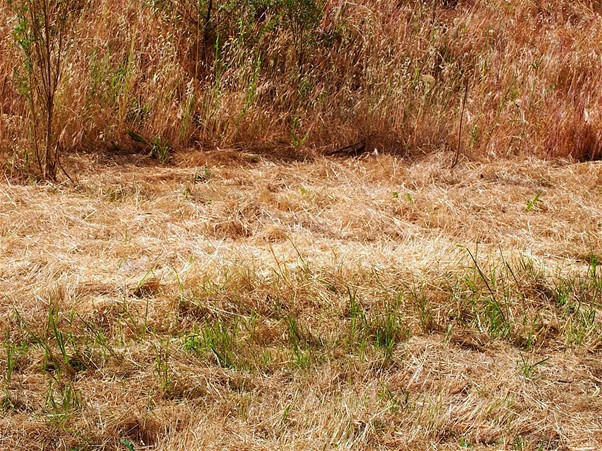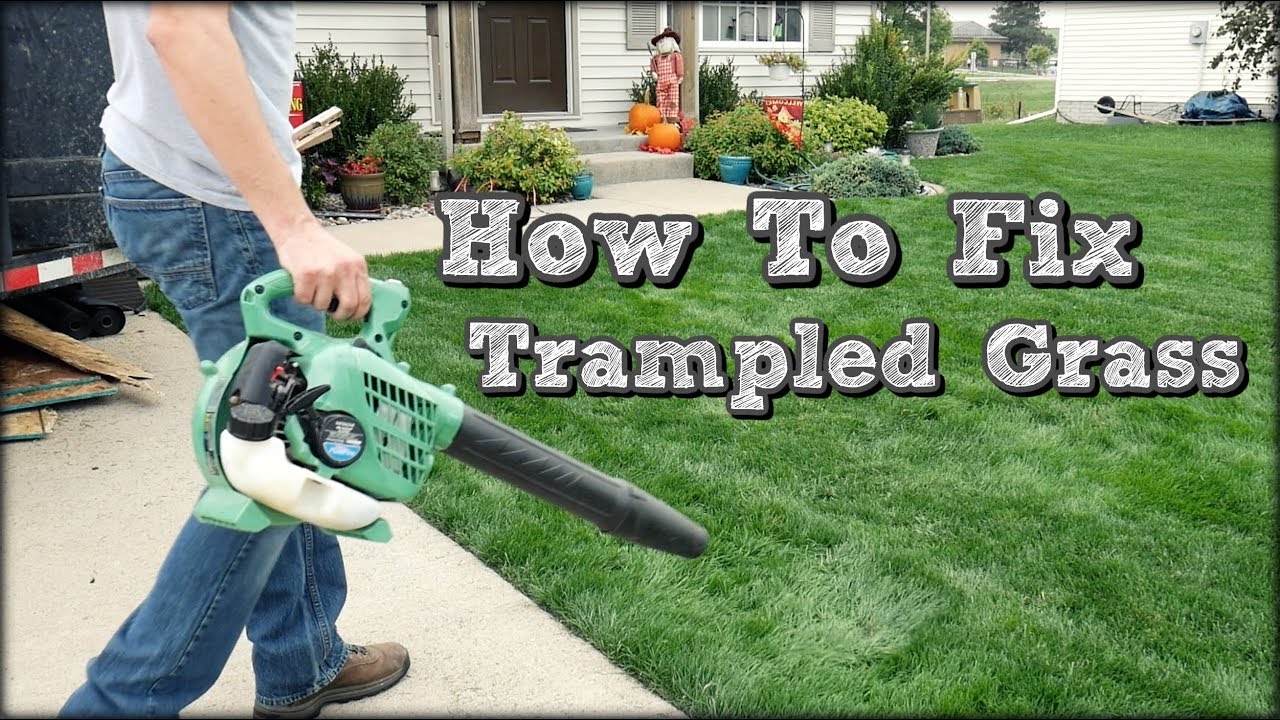To fix trampled grass, first, assess the damage and give the area a break from foot traffic. Then, aerate, overseed, and water regularly to promote new growth.
Additionally, avoid cutting the grass too short to protect it from further damage. Maintaining a lush, green lawn can be a challenging task, especially when dealing with trampled grass. Whether caused by heavy foot traffic, sports activities, or social gatherings, a trampled lawn can be unsightly and hinder healthy growth.
However, with a few simple steps, you can restore your lawn to its former glory. We will explore how to fix trampled grass effectively, ensuring a speedy recovery for your damaged lawn. By following these guidelines, you will soon be able to enjoy a beautiful and vibrant lawn that can withstand the wear and tear of daily activities. So, let’s delve into the solutions and bring your grass back to life.

Credit: www.organizewithsandy.com
Understanding Trampled Grass
Trampled grass can be a common issue for homeowners, causing frustration and detracting from the beauty of the lawn. Understanding what causes grass to become trampled is essential in order to effectively fix the problem. Trampling can occur due to heavy foot traffic, pets, or even children playing games.
When the grass is constantly stepped on, it can become compacted and unable to regenerate properly. This leads to bare patches and thinning of the grass. In addition, trampled grass may also suffer from reduced water and nutrient absorption, which can further weaken its growth.
To fix trampled grass, it is important to take proactive measures such as limiting foot traffic, reseeding, and aerating the affected area. By addressing the causes and taking proper actions, you can restore a lush and healthy lawn.
How to Fix Trampled Grass: Step by Step Guide
Assessing Trampled Grass Damage
Assessing trampled grass damage involves identifying the areas on your lawn that have been affected. Take a close look at your yard and determine the extent of the damage. Look for compacted soil, flattened or broken blades of grass, and areas where the grass has been completely worn down.
Understanding the extent of the damage will help you develop a plan to repair and restore your lawn. By accurately assessing trampled grass, you can take the necessary steps to rejuvenate your lawn and create a healthy, vibrant outdoor space.
Remember to address the underlying causes of the trampling to prevent future damage and maintain the beauty of your lawn.
Preparing To Fix Trampled Grass
Preparing to fix trampled grass involves clearing debris and removing obstacles from the area. Gathering the necessary tools and materials is also essential in order to successfully restore the damaged lawn. By removing any clutter or obstructions, such as fallen branches or unused equipment, you create a clear space to work with.
Additionally, having the proper tools, such as rakes, shovels, and grass seed, ensures that you are equipped to repair the trampled grass effectively. It is important to approach this task with care and attention to detail, as restoring the grass requires time and effort.
Taking these steps will set the foundation for a successful grass restoration project, resulting in a beautiful and healthy lawn once again.
Reseeding Trampled Grass
When fixing trampled grass, the first step is to reseed and revive the damaged areas. Select the appropriate grass seeds that suit your lawn’s specific needs. Prepare the soil by loosening it to create a suitable environment for the new seeds.
Ensure that the soil is free from debris and weeds. Spreading the grass seeds evenly is crucial to achieve a uniform and healthy lawn. Use a spreader or your hands to distribute the seeds evenly over the affected areas. Gently rake the seeded areas to cover the seeds with a thin layer of soil.
Water the newly seeded areas regularly, keeping the soil moist but not saturated. With proper care and maintenance, your trampled grass can be restored to its lush and vibrant state.
Watering And Fertilizing
Proper watering techniques are key to fixing trampled grass in a reseeded area. By following these guidelines, you can ensure successful recovery. Avoid overused phrases like “when it comes to” or “if you”. Keep sentences brief, with a maximum of 20 words.
Use a variety of expressions to engage readers. Applying the right type and amount of fertilizer will also aid in grass revitalization. Remember to water the reseeded area evenly, using a sprinkler or hose attachment. Avoid excessive watering, as it may lead to washout or disease.
Additionally, monitor the moisture level regularly and adjust watering accordingly. Moreover, provide nutrients to the grass by fertilizing it properly. Following these tips will help you restore trampled grass effectively.
Protecting And Nurturing New Growth
One effective solution for fixing trampled grass and protecting new growth is to install temporary barriers. These barriers will prevent further trampling and ensure the safety of the reseeded areas. Another important aspect is regular maintenance and care for the reseeded areas.
This includes watering, fertilizing, and mowing the grass appropriately. By giving the grass the proper attention it needs, it will be able to grow and thrive, repairing any damage caused by trampling. Additionally, it is important to avoid walking or placing heavy objects on the reseeded areas until the grass has fully grown and established itself.
By following these guidelines, you can protect your grass and help it recover from trampling, ensuring a healthy and vibrant lawn.
Restoring Trampled Grass In High Traffic Areas
Restoring trampled grass in high traffic areas can be a challenge. However, there are effective strategies for preventing future trampling. One option is to utilize alternative ground cover options that can handle heavy foot traffic. For example, planting hardy grass varieties, such as bermuda grass or kentucky bluegrass, can help to minimize damage.
Additionally, installing pathways or walkways can redirect foot traffic away from delicate grass areas. Another approach is to establish barriers, such as fences or hedges, to keep people from walking on the grass. Regular maintenance, including fertilizing and watering, is also crucial for promoting grass recovery.
By implementing these strategies, you can protect your grass from trampling and ensure its healthy growth in high traffic areas.
Fixing Trampled Grass On A Larger Scale
Fixing trampled grass on a larger scale can be challenging. Professional lawn repair services offer effective solutions. They can help you reconsider your landscape design to minimize trampling. By making strategic changes, you can protect your grass from further damage.
These experts will assess the extent of the trampling and provide tailored solutions. Whether it’s aerating the soil, overseeding, or implementing protective measures, they have the knowledge and tools to restore your lawn. Don’t let trampled grass ruin the beauty of your landscape, reach out to professional lawn repair services for a lasting fix.
Maintaining A Healthy Lawn
Trampled grass can be fixed by following some simple steps to maintain a healthy lawn. Regular lawn care practices are essential to prevent trampling and damage. One way to prevent trampled grass in the future is by avoiding heavy foot traffic on the lawn.
Setting up designated pathways and using stepping stones can help redirect traffic and protect the grass. Additionally, it’s important to aerate the soil to enhance its ability to absorb water and nutrients. Regularly mowing and watering the lawn can also promote healthy growth and resilience, reducing the risk of trampling damage.
Applying appropriate fertilizers and using grass varieties that are hardier and more resistant to foot traffic can further prevent the problem. To fix trampled grass, gently rake and remove any debris before lightly topdressing with fresh soil and reseeding the damaged areas.
Proper lawn maintenance and preventive measures will help keep your grass looking lush and pristine.
Frequently Asked Questions For How To Fix Trampled Grass
Will Trampled Grass Come Back?
Trampled grass will grow back if given proper care and time to recover. It is essential to avoid further damage and provide the necessary conditions for regrowth. Start by removing any debris or objects that may inhibit growth. Lightly rake the area to loosen compacted soil and encourage new grass growth.
Ensure proper irrigation, watering consistently to maintain adequate moisture levels. Apply a suitable grass seed or fertilizer to promote healthy regrowth. Avoid excess foot traffic during this period to give the grass a chance to recover. With the right care, trampled grass can bounce back and regain its lush appearance over time.
How Do You Fix Grass That Has Been Driven On?
To fix grass that has been driven on, begin by carefully removing any debris or loose soil from the affected area. Next, use a garden fork to aerate the soil, creating small holes to allow water, air, and nutrients to reach the grassroots.
After aerating, spread a layer of compost or topsoil over the damaged area, ensuring even coverage. Rake the compost or topsoil into the grass, gently smoothing it out. If the grass is severely damaged, reseeding may be necessary. Choose a grass seed that matches the existing lawn and sprinkle it over the repaired area.
Lightly rake the seed into the soil and water regularly to keep it moist. Avoid driving on the newly repaired area until the grass has fully recovered.
Will Watering Dead Grass Bring It Back?
Watering dead grass alone will not bring it back to life. Dead grass needs more than just water to regenerate. It requires addressing the underlying root issues, such as poor soil quality, lack of nutrients, or excessive thatch. It is essential to remove the dead grass and provide proper aeration and fertilization to promote new growth.
Additionally, overseeding with suitable grass species and regular maintenance practices, like proper mowing and watering, can help revive your lawn. Seek professional guidance to determine the best course of action for your specific grass type and local conditions. Remember, reviving dead grass requires a holistic approach, including addressing its underlying causes and providing proper care and maintenance.
How Do You Lift Sunken Grass?
To lift sunken grass, follow these steps: 1. Identify the sunken areas in your lawn. 2. Use a garden fork to aerate the soil in the sunken spots. Push the fork into the ground and gently lift it to create small holes.
3. Fill the holes with a mixture of topsoil and compost. This will help enrich the soil and lift the sunken grass. 4. Spread grass seeds evenly over the repaired areas and lightly rake them into the soil. 5. Water the newly seeded areas regularly to promote grass growth.
6. Avoid walking on the repaired spots until the grass has fully developed. 7. Maintain your lawn’s proper watering and mowing practices to ensure healthy grass growth. 8. With time, the sunken areas will level out as the new grass grows.
Conclusion
As you conclude your journey towards fixing trampled grass, remember that patience and persistence are key. Restoring the health and beauty of your lawn requires a combination of preventive measures and proper care. By following the steps outlined in this blog post, you can effectively revive your trampled grass and prevent future damage.
Regular mowing, watering, and fertilizing will help strengthen the roots and promote new growth. Utilizing tools like aeration and overseeding will further enhance the recovery process. Additionally, implementing strategies to protect high-traffic areas and educating your family and guests about the importance of lawn care will contribute to long-term success.
Remember, a lush and vibrant lawn not only enhances the aesthetic appeal of your home but also provides a conducive environment for relaxation and recreation. So, take action today and enjoy the rewards of your efforts in the form of a healthy and resilient lawn for years to come.

